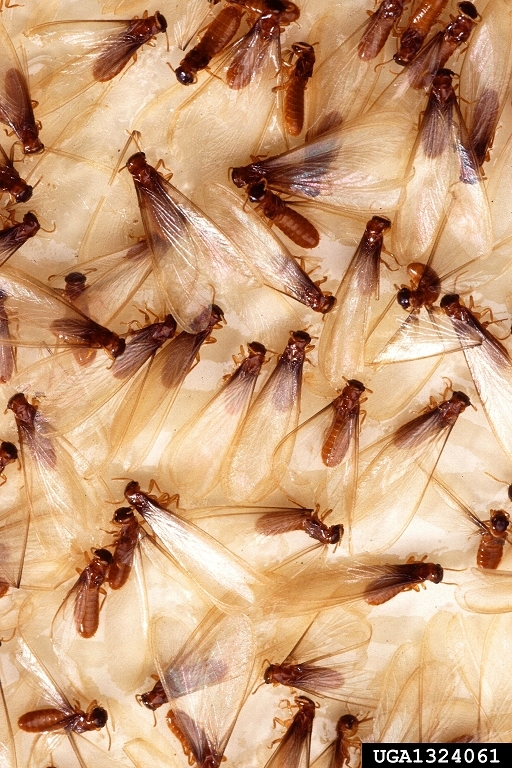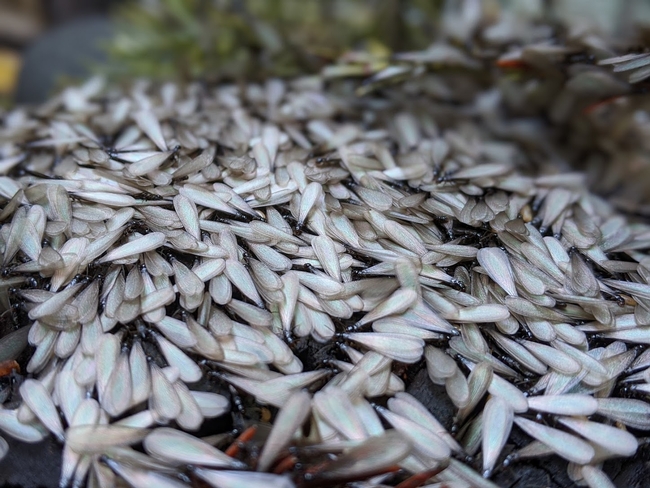The Formosan subterranean termite (FST), Coptotermes formosanus, is a very destructive pest first reported in California in 1992 in La Mesa, San Diego County. FST has since been found in Canyon Lake, Riverside County, Rancho Santa Fe (San Diego County) and Highland Park (Los Angeles County).
While this termite species is currently only found in a few locations in Southern California, it's important for residents and professional pest managers to be aware of them. Wood destroying pests can easily be moved through human activities.
To identify Formosan termites, UC IPM advisor Dr. Siavash Taravati and Dr. Chow-Yang Lee of UC Riverside developed this poster. Email them at starvati@ucanr.edu or chowyang.lee@ucr.edu if you see any termites resembling those in the poster.
For Pest Management Professionals: Is the management for Formosan termites the same as management for native subterranean termites?
The short answer is “it depends!”. Formosan subterranean termites (FST) can form extremely large colonies in the field reaching millions of individuals. When the active nests are primarily in the ground, most colony members stay in the ground except when foraging for food. In this case, in-ground baiting is used against native subterranean termites and it may provide adequate control. However, some FST colonies could be formed above the ground (aerial) with no or limited contact with the soil. In-ground baiting is unlikely to be effective for managing such aerial colonies.
If you are a structural PMP, read more in the Spring 2023 Green Bulletin Newsletter.
To learn more about subterranean termites and their management, see Pest Notes: Subterranean and Other Termites.
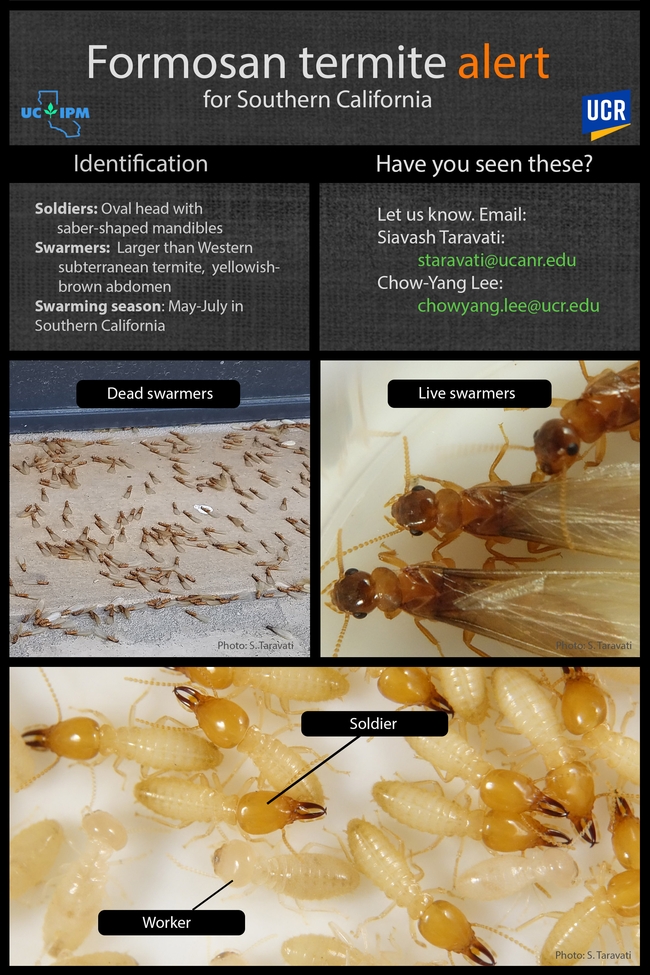
Termite Awareness Week is a campaign created by the National Pest Management Association to call attention to the damage termites can cause to structures and to make sure residents and professional pest managers understand how to prevent and deal with termite infestations.
Did you know?
- Of the 23 species of termites in California, only 3 are considered pests. The three pest species are dampwood, drywood, and subterranean termites.
- Subterranean termites are the most common in California. They live in underground nests and can be found infesting wood that is in contact with the soil, including structural lumber in homes and landscapes, as well as fallen trees, tree stumps, or other dead wood.
- If you come across groups of insects on the ground that appear to be winged termites, they may actually be winged ants. For help distinguishing ants from termites, see the UC IPM Ant Key.
- Dampwood termites are larger than subterranean and drywood termites. They are most common in cool, humid areas along the coast and are attracted to lights at dark.
- Termites play a very important role in California forests, woodlands and deserts by helping to break down woody organic matter which helps return nutrients to the soil. And contrary to popular belief, termites rarely injure or kill healthy trees.
If you suspect you might have a termite infestation in your home, contact a professional. Do-it-yourself insecticide treatments are not recommended and are often not effective. To learn more about termites and available management strategies for professionals, read the Pest Notes: Subterranean and Other Termites and the Pest Notes: Drywood Termites.
- Author: Andrew Mason Sutherland
It's that time of year again: termite swarm season! Western subterranean termites, Reticulitermes hesperus (species complex), produce reproductive swarms during calm sunny periods immediately following the first autumn rains. This is especially pronounced in the San Francisco Bay Area and parts of the Sacramento Valley, where mature termite colonies across a broad region may swarm simultaneously en masse, filling the air with termites fluttering their gossamer wings and filling social media discussions with wonder, horror, confusion, and dread.
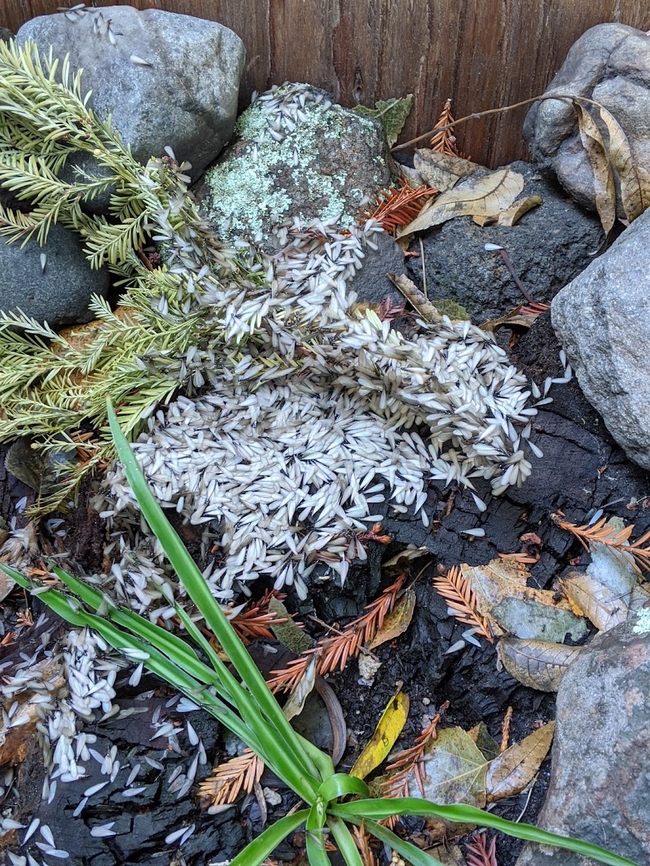
(Credit: C Hubble)
What should you do? If observing a swarm on your property, especially if near your home or other structures, you can hire a professional termite company for a detailed inspection. Make sure to photograph or otherwise note the swarm location so that the inspector can start there. Even if you don't see swarms on your property, regular (every three to five years) inspections will help detect infestations before they cause significant damage and prevent future infestations. There are several proven management strategies for termites; review UC IPM's Pest Notes: Subterranean Termites.
For now, perhaps we can all appreciate the wonder of this natural spectacle. Winged termites are great sources of food for birds, lizards, other insects, and spiders. Termites also provide important ecosystem services, such as decomposition of wood and fallen leaves, contribution to soil structure formation, enhancement of water infiltration in soil, and facilitation of nutrient availability to plants. Furthermore, western subterranean termites are native to California and have been here long before we built wooden structures on top of their colonies. (Termite) love is in the air!

- Author: Karey Windbiel-Rojas
[From the Pests in the Urban Landscape blog]
Spring is here which means pest activity is on the rise. Termites are one of the top pest concerns for many city dwellers and rural residents alike. The infographic shows some interesting facts about termites.
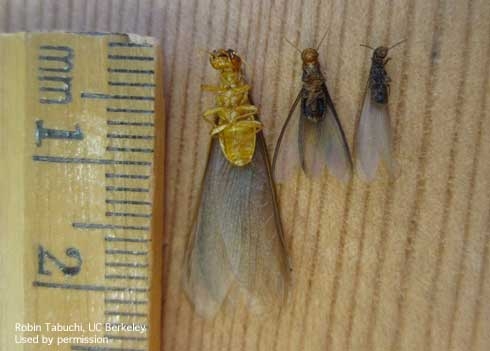
Here in California, there are three kinds of termites considered pests including subterranean, drywood, and dampwood termites. The Formosan termite is one kind of subterranean termite found in California, although in limited areas.
Treatments differ for each type of termite, but there are many things you can to reduce infestations. This includes removing wood piles and scrap wood around the home, keeping substructures dry and well ventilated, and finishing exterior wood with sealants or paint.
If you are experiencing termite issues, consult the UC IPM Pest Notes publications Subterranean and Other Termites, Drywood Termites, and Hiring a Pest Control Company.

![Reproductives of dampwood, drywood and subterranean termites (L-R). [R. Tabuchi] Reproductives of dampwood, drywood and subterranean termites (L-R). [R. Tabuchi]](http://ucanr.edu/blogs/UCIPMurbanpests/blogfiles/35186.jpg)
Did you know?
- Of the 23 species of termites in California, only three are considered pests. The three pest species are dampwood, drywood, and subterranean termites.
- Subterranean termites are the most common in California. They can be found infesting wood that is in contact with the soil, including structural lumber in homes and landscapes, as well as fallen trees, tree stumps, or other dead wood.
- If you come across groups of insects on the ground that appear to be winged termites, they may actually be winged reproductive ants. Check the Termites Quick Tip card to see the distinguishing features of ants and termites.
- Termites play a very important role in California forests, woodlands and deserts. Termites help break down woody organic matter which helps return nutrients to the soil. And contrary to popular belief, termites rarely injure or kill trees.
If you suspect you might have a termite infestation in your home, contact a professional. Do-it-yourself sprays are not recommended and are not effective. To learn more about termites, read the Subterranean and Other Termites Pest Note and the Drywood Termites Pest Note on the UC IPM web site.

